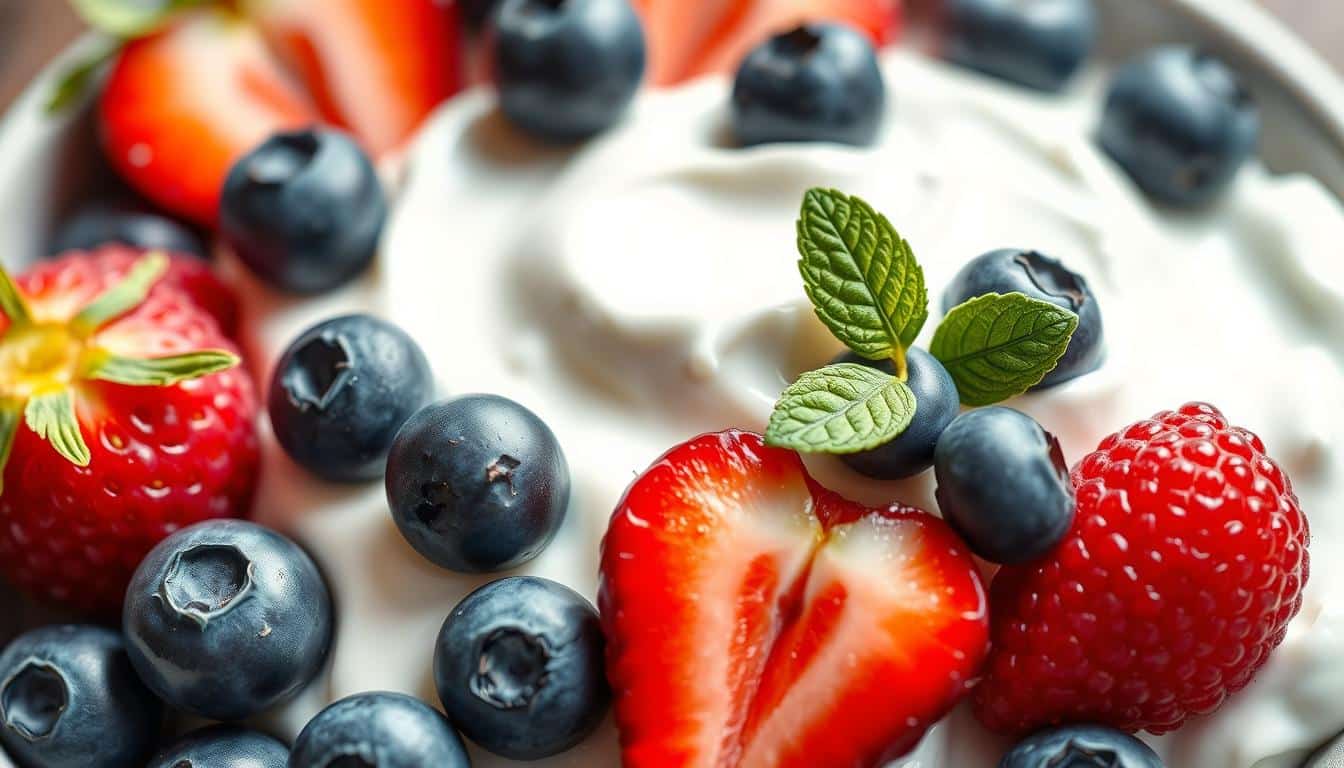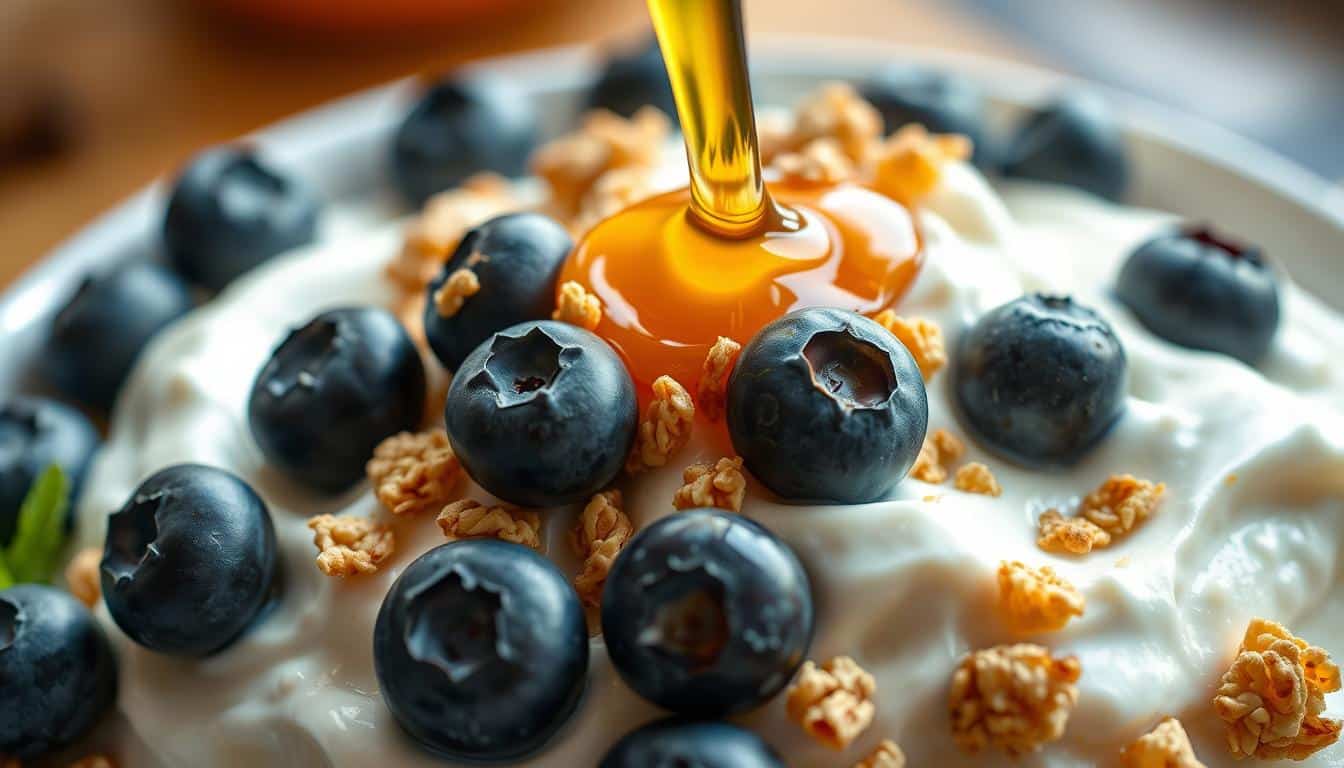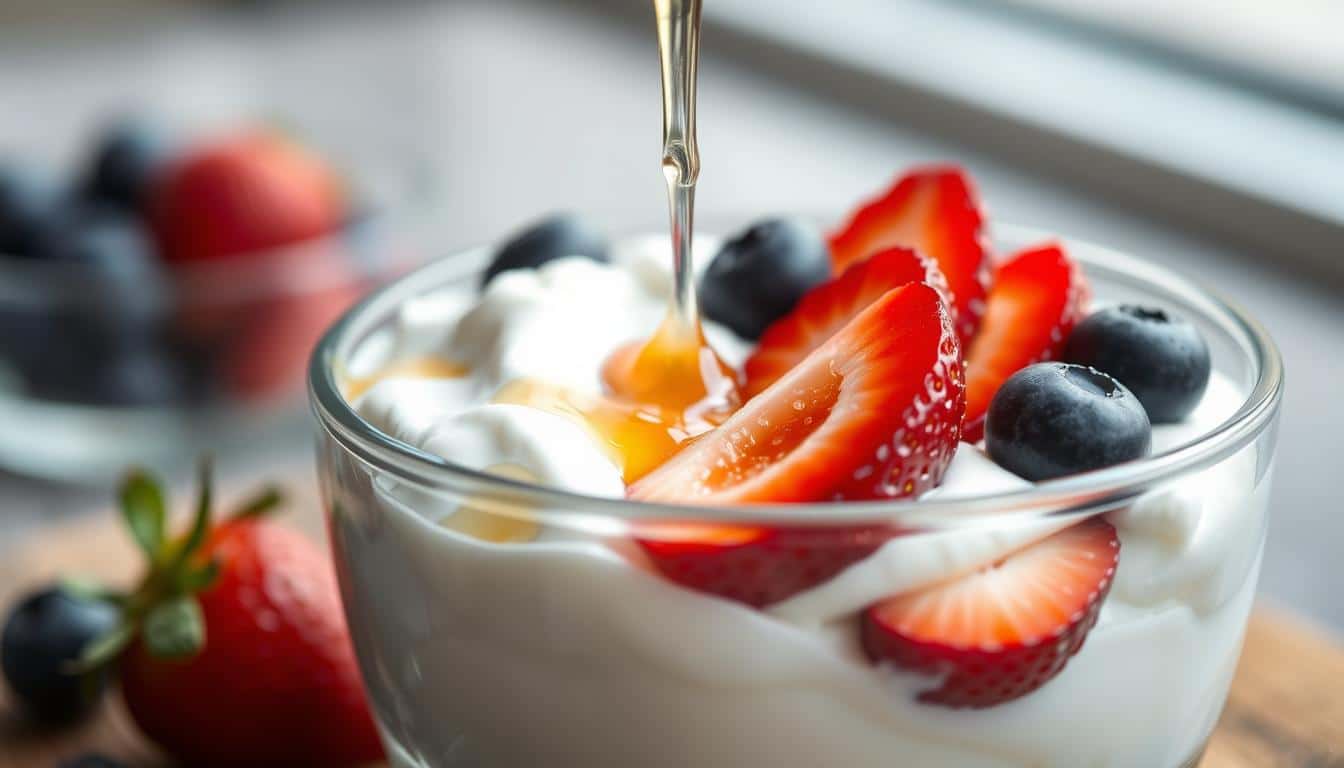Are you looking for the perfect snack to fuel your next workout? Many fitness enthusiasts turn to Greek yogurt for its high protein content and quick digestion. But is it the best choice for you?
Nutrition experts like Mackenzie Burgess recommend it 1-2 hours before exercise to support muscle recovery. Meanwhile, Cara Harbstreet suggests low-fat snacks 30 minutes prior to training for sustained energy. Let’s break down the pros and cons to help you decide.
From its popularity as a fitness snack to how it compares with alternatives like cottage cheese or smoothies, we’ll explore everything you need to know. Ready to make your next workout even better? Let’s dive in!
Introduction to Greek Yogurt as a Pre-Workout Snack
Wondering what to eat to power through your next gym session? The right pre-workout snack can make all the difference. It provides energy, preserves muscle, and helps you perform at your best. According to recent data, 59% of gym-goers prefer quick-digesting options to fuel their routines.
Among these, Greek yogurt has gained popularity as a top choice. It ranks #5 in Mackenzie Burgess’ list of the best pre-workout foods. With 15-20 grams of protein per serving, it supports muscle repair and keeps you feeling full without weighing you down.

Pairing it with fruits or honey adds natural sweetness and carbs for sustained energy. Unlike heavy snacks like legumes or cruciferous veggies, it’s less likely to cause bloating or discomfort during exercise.
Here’s a quick comparison of Greek yogurt with other common pre-workout snacks:
| Snack | Protein (g) | Carbs (g) | Digestion Speed |
|---|---|---|---|
| Greek Yogurt | 15-20 | 6-8 | Quick |
| Banana | 1 | 27 | Quick |
| Protein Bar | 20 | 25 | Moderate |
| Oatmeal | 5 | 27 | Slow |
Choosing the right food before exercise is key to optimizing your performance. Greek yogurt offers a balanced mix of protein and carbs, making it a standout option for active individuals.
Nutritional Benefits of Greek Yogurt
Want to know what makes a great pre-exercise snack? It’s all about the nutrients that fuel your body and support your performance. Let’s dive into the key components that make this snack a standout choice.
Protein Content
One of the biggest advantages is its high protein content. A 7-ounce serving packs 15-20 grams of protein, which is nearly double the amount found in regular yogurt. This helps build and repair muscle, especially during intense training sessions.
According to Mackenzie Burgess, “Protein promotes the recovery process.” It also prevents muscle breakdown, ensuring you stay strong and ready for your next workout.
Carbohydrates and Energy
Carbohydrates are another essential component. Plain varieties contain 5-8 grams of natural sugars, while flavored versions can have 15 grams or more. The natural lactose provides a quick energy boost, perfect for fueling your exercise.
Pairing it with a banana or a drizzle of honey adds extra carbs, which help replenish glycogen stores. Timing is key—eating carbs before exercise ensures you have the energy to power through your routine.

| Type | Protein (g) | Sugar (g) |
|---|---|---|
| Plain | 15-20 | 5-8 |
| Flavored | 15-20 | 15+ |
Choosing the right source of nutrients can make a big difference in how you feel and perform. Whether you’re lifting weights or running a marathon, this snack has the balance you need.
Greek Yogurt Before Workout: Pros and Cons
Curious about the best way to fuel your active lifestyle? Choosing the right pre-workout snack can make a big difference in how you feel and perform. Let’s break down the advantages and potential drawbacks to help you decide if this option is right for you.
Why It’s a Great Choice
This snack offers several benefits for active individuals. First, it provides slow-release casein protein, which helps protect muscles during exercise. According to Mackenzie Burgess, this protein promotes recovery and keeps you feeling strong.
It also balances blood sugar better than simple carbs, giving you sustained energy. Plus, it’s a versatile base for energy-boosting toppings like fruits, nuts, or honey. This makes it easy to customize based on your preferences and needs.
Potential Drawbacks
While it’s a popular choice, it’s not perfect for everyone. For those with lactose sensitivity, it may cause stomach discomfort or bloating. It also requires 1-2 hours to digest fully, which might not suit heavy lifting sessions.
Overeating can lead to cramps, so portion control is key. If you’re unsure how your digestive system will react, start with a small amount and see how you feel.
| Aspect | Pros | Cons |
|---|---|---|
| Protein | Slow-release casein | May cause discomfort |
| Energy | Balances blood sugar | Requires digestion time |
| Versatility | Customizable toppings | Risk of overeating |
Ultimately, this snack can be a great addition to your routine if it works for your body. Pay attention to how you feel and adjust as needed to optimize your performance.
Timing Your Pre-Workout Snack
When you eat is just as important as what you eat before exercise. Your body needs the right fuel at the right time to perform its best. Let’s break down the ideal timing for different types of workouts.
For weight training, aim to eat 1-2 hours before your session. This gives your body enough time to digest and absorb nutrients. Mackenzie Burgess recommends this window for lifting to ensure you’re fueled without feeling heavy.
If you’re doing HIIT or cardio, a smaller snack 45 minutes before works well. Cara Harbstreet suggests this approach for light, quick-digesting options. It provides energy without overloading your stomach.
Morning workouts? Pair your snack with fast carbs like berries. This combo gives you an instant energy boost. Adjust the timing based on how quickly your body digests food. Everyone’s different, so listen to your body.
Short on time? If you have less than 30 minutes, opt for liquid fuel like a smoothie. It’s easier to digest and won’t weigh you down. Timing your meal right can make all the difference in your performance.
Combining Greek Yogurt with Other Foods
Ready to take your fitness fuel to the next level with creative mixes? Pairing your snack with nutrient-rich add-ons can boost both flavor and performance. Let’s explore some winning combinations that’ll keep you energized and satisfied.
Fruits and Nuts
Adding fruits and nuts is a simple way to enhance your snack. Banana slices are a great choice for potassium, which helps prevent muscle cramps. Blueberries, packed with antioxidants, add a sweet and tangy twist.
For healthy fats, sprinkle a tablespoon of almonds. They’re rich in nutrients but easy to digest in small amounts. Avoid raw seeds like chia, as they can cause bloating during exercise.
Granola and Honey
If you’re craving crunch, low-sugar granola is a fantastic option. It adds texture and complex carbs for sustained energy. Drizzle a teaspoon of honey for a quick carb boost that’s both natural and delicious.
Choose granola brands with minimal added sugar to keep it healthy. This combo is perfect for those who need a quick energy lift without feeling weighed down.
- Banana slices for potassium
- Blueberries for antioxidants
- Almonds for healthy fats (limit to 1 tbsp)
- Low-sugar granola for crunch
- Honey for fast carbs
Experiment with these combinations to find what works best for you. A little creativity can turn your snack into a powerhouse of nutrition and flavor.
Greek Yogurt vs. Other Pre-Workout Snacks
How does your pre-workout snack stack up? Let’s compare it to other popular foods to see which one fits your fitness goals best. Whether you’re looking for quick energy or muscle protection, this breakdown will help you decide.
Compared to cottage cheese, it digests faster, making it a better choice for those who need quick fuel. However, cottage cheese contains leucine, an amino acid that supports muscle recovery. If you’re aiming for recovery, this might be a better option.
Stroopwafels are another alternative. They provide quicker carbs, ideal for high-intensity workouts. But they lack the protein needed for muscle protection. Here’s a quick comparison of other popular snacks:
- Protein shakes: Less satiating but quicker to consume.
- Peanut butter toast: Higher in fat, which may slow digestion.
- Dates: Offer fast energy but lower protein content.
- Trail mix: Higher calorie density, which might not suit everyone.
- Rice cakes: Lacks the muscle-protecting benefits of protein-rich snacks.
Pairing it with a banana or whole grain options can enhance its benefits. These add-ons provide extra carbs and nutrients for sustained energy. Choose the snack that aligns with your workout intensity and dietary needs.
Digestive Considerations
Thinking about how your body handles food before exercise? Digestive comfort plays a big role in how you perform. For many, lactose intolerance can be a concern. Around 65% of adults have reduced lactase enzyme, which breaks down lactose in milk and cheese.
While this snack has less lactose than regular milk, it can still cause bloating or stomach discomfort for some. If you’re sensitive, try lactose-free versions or plant-based alternatives like soy or coconut options. These are easier on your system and still provide the nutrients you need.
Here’s a quick comparison of lactose content in common dairy products:
| Product | Lactose Content (per 100g) |
|---|---|
| Milk | 4.7g |
| Cheese | 0.1-2g |
| Greek Yogurt | 3g |
| Lactose-Free Yogurt | 0g |
If you’re doing inversions in yoga or intense workouts, avoid heavy snacks that might cause discomfort. Pairing your snack with ginger can help ease digestion. Remember, individual tolerance varies, so listen to your body and adjust as needed.
Personalizing Your Pre-Workout Nutrition
Ready to fine-tune your pre-workout nutrition for better results? Everyone’s body is different, so tailoring your fuel to your goals can make a big difference. Whether you’re into HIIT, strength training, or yoga, here’s how to optimize your routine.
For HIIT workouts, focus on carbs for quick energy. Add a drizzle of honey to your snack for an extra boost. Strength trainers should prioritize protein to support muscle repair. A slightly larger portion can help you train harder and recover faster.
Yogis and endurance athletes have unique needs too. Smaller servings 45 minutes before class work best for yoga. For endurance activities, adjust your intake based on sweat rate and electrolyte needs. Staying hydrated is key to peak performance.
Use a hunger scale (1-10) to gauge portion sizes. This helps you avoid overeating or feeling sluggish. Track your energy levels to see what works best for your body. Small adjustments can lead to big improvements.
| Activity | Focus | Tip |
|---|---|---|
| HIIT | Carbs | Add honey for quick energy |
| Strength Training | Protein | Increase portion size |
| Yoga | Light Snack | Eat 45 minutes before class |
| Endurance | Hydration | Adjust based on sweat rate |
Personalizing your pre-workout nutrition isn’t complicated. Start with these tips and adjust as needed. Your body will thank you!
Expert Opinions on Greek Yogurt Before Workouts
Looking for expert advice on pre-exercise snacks? Nutrition professionals have weighed in on the best ways to fuel your body for peak performance. Here’s what they recommend.
Mackenzie Burgess suggests pairing your snack with homemade granola. “It’s ideal 1 hour before weight training,” she says. This combination provides a mix of protein and carbs to support muscle repair and energy levels.
Leslie Bonci advises avoiding large portions before high-intensity intervals. “Combine it with quick carbs like fruit for cardio sessions,” she notes. This ensures you get an energy boost without feeling weighed down.
Natalie Rizzo cautions against overeating before intense workouts. “Stick to smaller portions for high-intensity intervals,” she recommends. This helps prevent discomfort and keeps you focused on your routine.
Cara Harbstreet emphasizes portion control. “Match your snack size to the length of your workout,” she explains. Shorter sessions may require lighter snacks, while longer ones benefit from more substantial fuel.
The consensus? Timing and portion size are key. When done right, this snack can be a powerful addition to your pre-exercise routine.
| Expert | Recommendation |
|---|---|
| Mackenzie Burgess | Pair with granola 1 hour before weights |
| Leslie Bonci | Combine with quick carbs for cardio |
| Natalie Rizzo | Small portions for high-intensity intervals |
| Cara Harbstreet | Adjust portion size based on workout length |
Conclusion: Is Greek Yogurt the Right Choice for You?
Is this the right snack to power your fitness routine? For many, the answer is yes. With its protein content and quick digestion, it’s a solid option for morning trainers and weightlifters. Surveys show it works for 60% of active individuals.
However, if you’re lactose-sensitive or have less than 30 minutes before exercise, it might not be ideal. For those with immediate workouts, try alternatives like cottage cheese for slower digestion.
Pair it with berries and slivered almonds for extra energy and flavor. This combo keeps your body fueled without weighing you down.
Final tip? Track your performance three times before deciding. This helps you see if it’s the right fit for your routine. Listen to your body and adjust as needed!


